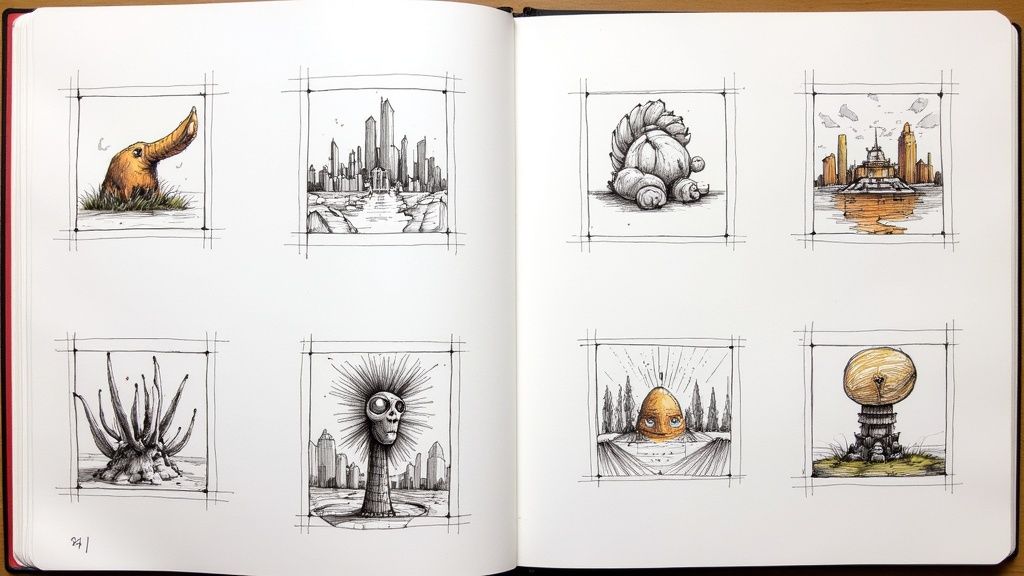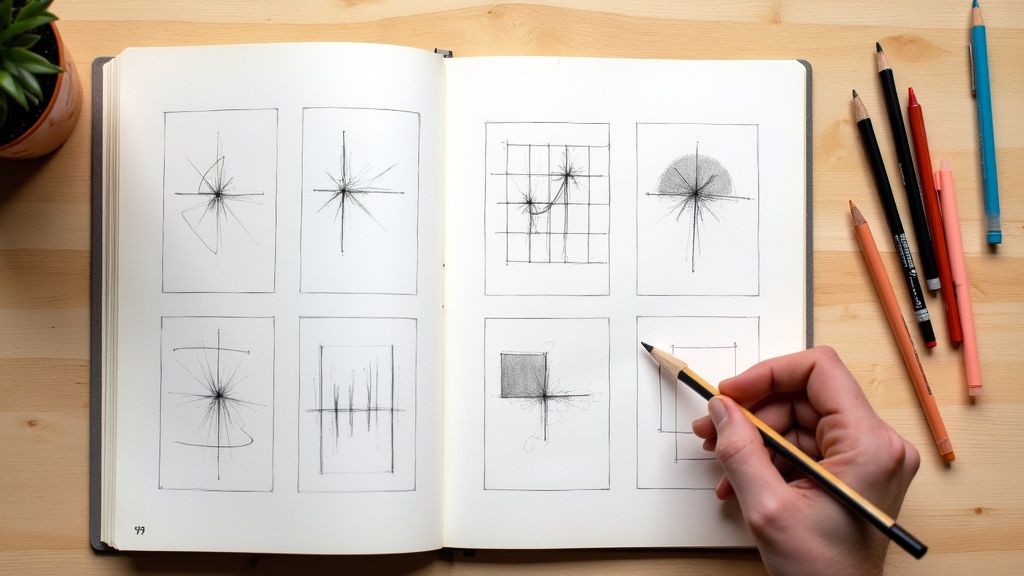Every artist, from the seasoned professional to the weekend doodler, has faced the dreaded blank page. The question ‘what to draw what to draw?’ can echo in the quietest moments, turning a canvas of possibility into a source of paralysis. This isn't just about a lack of skill; it's about the overwhelming freedom of infinite choice.
Creative blocks are not a sign of failure but a common hurdle in the artistic journey. The key is to transform that question from a roadblock into a launchpad. This guide moves beyond generic advice, offering seven distinct, actionable methods to spark inspiration and give you a concrete answer for what to draw.
We'll explore structured challenges that build habits, spontaneous exercises that sharpen observation, and expressive techniques that connect your art to your emotions and memories. Whether you have five minutes or a full afternoon, these prompts are designed to be adaptable and effective. Prepare to fill your sketchbook with purpose and discover fresh perspectives that will reignite your passion for drawing. You'll leave with a practical toolkit of ideas, ensuring you always have a starting point.
1. 30-Day Drawing Challenge
When you’re stuck wondering what to draw, what to draw, a structured challenge can be the perfect catalyst to reignite your creative spark. A 30-day drawing challenge is a commitment to create one piece of art every day for a month, typically following a list of pre-set prompts. This approach removes the daily pressure of choosing a subject, allowing you to focus purely on the act of creation and building a consistent drawing habit.
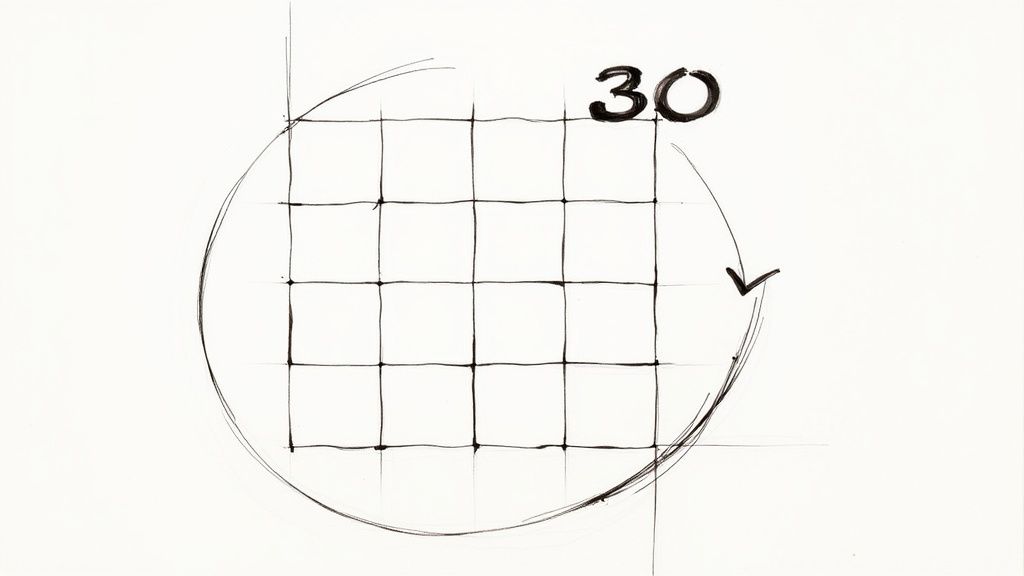
This method is incredibly effective for overcoming creative blocks because it builds momentum. The daily practice not only hones your technical skills but also retrains your brain to think creatively on command. It’s an ideal solution for artists who feel rusty, want to explore new themes, or struggle with procrastination.
How to Get Started
Embarking on a 30-day challenge is simple. The key is to reduce friction and make drawing an easy, accessible part of your daily routine.
- Find Your Prompts: The internet is filled with prompt lists for challenges like Inktober (ink-based art in October) or themed challenges focused on portraits, animals, or fantasy. Choose a list that genuinely excites you to maintain motivation.
- Keep It Simple: You don't need to create a masterpiece every day. Aim for 10-15 minute sketches, especially at the beginning. The goal is completion, not perfection.
- Prepare Your Tools: Have a dedicated sketchbook and your favorite pens or pencils ready to go. By having your materials accessible, you eliminate a common excuse not to start.
- Share Your Journey: Post your daily drawings on social media using the challenge’s hashtag. This creates a sense of accountability and connects you with a community of artists doing the same thing.
A daily challenge is less about the final product and more about the process of showing up consistently. It proves that small, daily efforts compound into significant artistic growth over time.
Ultimately, a 30-day challenge forces you out of your comfort zone while providing a supportive structure. It’s a powerful tool for skill development and a reliable answer when you just don't know what to draw. For more ideas and prompt lists, you can explore various daily drawing challenges that might suit your style. For a deeper dive into this concept, you can learn more about daily drawing challenges and find a prompt list that inspires you.
2. Random Object Drawing
When you find yourself stuck asking what to draw, what to draw, the simplest answer is often right in front of you. Random object drawing is a spontaneous practice where you select an everyday item and draw it without overthinking. This method trains your artistic eye to find beauty and complexity in the mundane, dramatically improving your observational skills and building confidence in rendering unfamiliar forms.
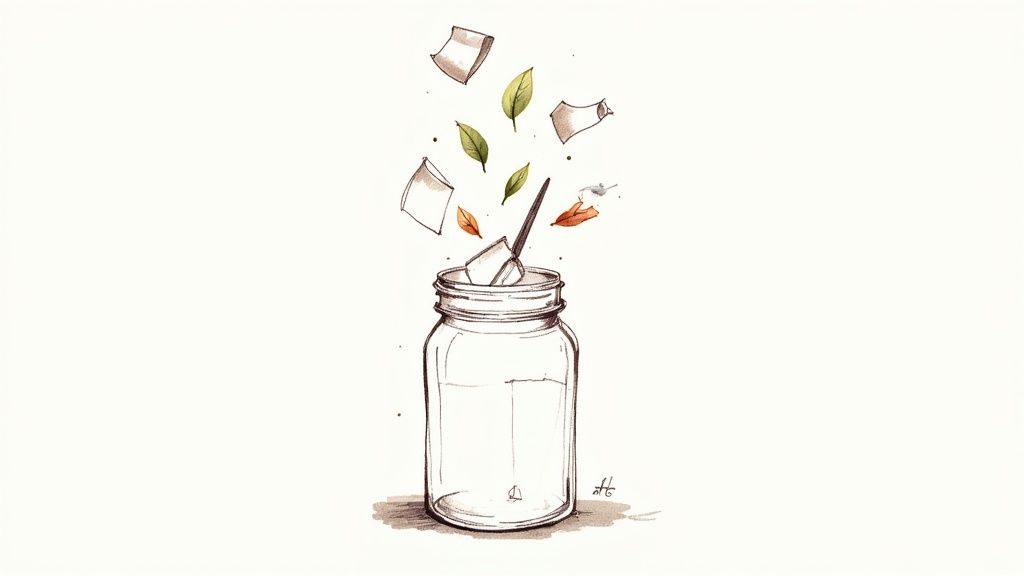
This approach is incredibly effective for breaking creative blocks because it removes the pressure of inventing a subject from scratch. By focusing on a simple object, like a kitchen utensil or a houseplant, you can concentrate on fundamental skills like form, light, and texture. It's a foundational exercise used in classical art education to teach students how to truly see before they draw.
How to Get Started
Getting started with random object drawing is about embracing spontaneity and observation. The key is to pick an object and begin drawing without judgment.
- Create an 'Object Jar': Write down names of common household items on small pieces of paper (e.g., keys, teacup, scissors, book) and put them in a jar. When you need an idea, just pull one out.
- Study From Multiple Angles: Don't just draw an object once. Draw your chosen item, like a hammer or a plant, from several different viewpoints to understand its three-dimensional form.
- Focus on Light and Shadow: Pay close attention to how light hits the object and creates shadows. This is more important than a perfect outline and will give your drawing depth and realism.
- Set a Time Limit: Use a timer (5-10 minutes) to keep your drawing loose and prevent you from getting bogged down in tiny details. The goal is to capture the essence of the object, not a photorealistic copy.
The power of drawing random objects is that it teaches you that interesting subjects are everywhere. You don't need a grand landscape or a dramatic portrait to make compelling art; a simple spoon can be just as captivating.
Ultimately, this practice is a reliable solution when you don't know what to draw because it's accessible, requires minimal setup, and delivers significant skill improvements. It’s about rediscovering the world around you one object at a time. For more ways to generate spontaneous ideas, you can find a variety of random art prompts that will keep your sketchbook full.
3. Emotion and Mood Drawing
When you're searching for what to draw, what to draw, consider looking inward instead of outward. Emotion and mood drawing is a powerful expressive method where the goal is to translate feelings into visual art. Instead of focusing on a literal object or scene, you use colors, lines, and shapes to convey a specific emotional state, like joy, anger, or tranquility.
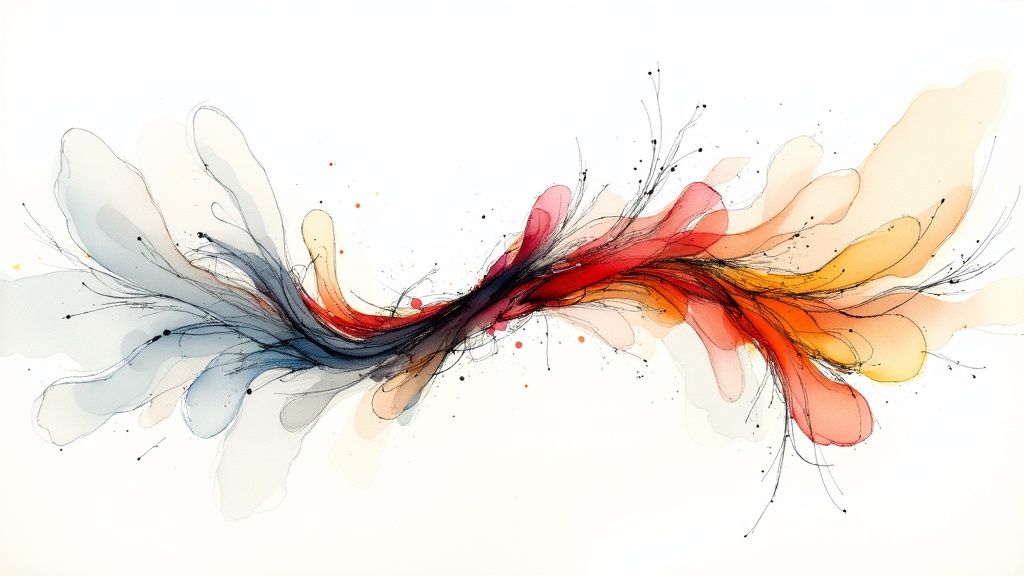
This approach is perfect for breaking free from the pressure of realism and technical perfection. It connects you directly to the intuitive side of your creativity, making it a highly personal and therapeutic exercise. By concentrating on how a feeling looks, you unlock a new visual language pioneered by artists like Wassily Kandinsky and Jackson Pollock, who used abstraction to express their inner worlds.
How to Get Started
Channeling emotions onto paper is a freeing experience that requires you to let go of preconceived ideas. The key is to trust your instincts and let the feelings guide your hand.
- Choose an Emotion: Start by focusing on a single, clear emotion. It could be something you are currently feeling or one you wish to explore, such as "peace," "excitement," or "melancholy."
- Assign Visuals to Feelings: Before you start, think about what colors and marks represent that feeling to you. For example, anger might be sharp, jagged red lines, while peace could be soft, flowing blue and green curves.
- Draw Intuitively: Put your tool to paper and let your hand move freely. Don't plan or overthink the composition; focus on the physical act of making marks that feel like the emotion.
- Keep an Emotion Journal: Dedicate a section of your sketchbook to exploring different feelings. This creates a personal library of visual-emotional associations you can draw inspiration from later.
Drawing an emotion is not about creating a recognizable picture. It’s about making marks that feel true to the emotion itself, resulting in a visual diary of your inner state.
Ultimately, drawing emotions is a fantastic solution when you feel creatively blocked or emotionally overwhelmed. It shifts the focus from "what should I draw?" to "how do I feel?" turning your sketchbook into a space for self-expression and discovery. For those interested in the link between art and psychology, exploring the principles of art therapy can provide deeper insights into this practice.
4. Memory Drawing Exercises
If you find yourself asking what to draw what to draw, the answer might already be in your head. Memory drawing is a powerful exercise where you create art without any visual reference, relying solely on your mental image of a subject. This practice forces you to move beyond simple copying and truly understand an object’s form, proportion, and details.
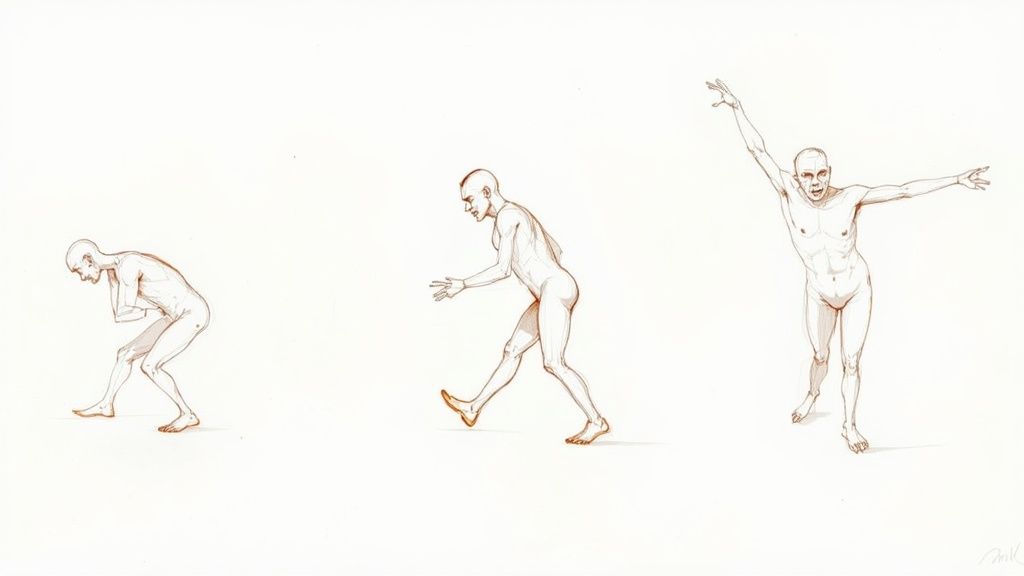
This method is incredibly effective for developing a deeper visual library and strengthening your ability to draw from imagination. By challenging yourself to recall details, you train your brain to observe more carefully in the future. It’s an ideal solution for artists who want to break their dependency on reference photos and gain the freedom to create scenes and characters entirely from their minds.
How to Get Started
Beginning with memory drawing is about starting small and building your visual recall muscle over time. The key is to be patient and treat it as a training exercise rather than a test.
- Start with the Familiar: Begin with subjects you know intimately. Try sketching your childhood home, a familiar pet without looking at photos, or the layout of your current room.
- Focus on Big Shapes First: Don't get bogged down in tiny details. Concentrate on capturing the overall gesture, form, and primary shapes of your subject. Details can be added later.
- Observe, Hide, Draw: A great exercise is to study an object for one minute, then hide it and try to draw it from memory. Afterward, compare your drawing to the real object to see what you missed.
- Accept Imperfection: Your first attempts will likely be inaccurate, and that's the point. The goal is not a perfect drawing but to identify gaps in your visual memory and improve your observational skills.
Memory drawing is less about accurate representation and more about strengthening the connection between your eyes, your brain, and your hand. It teaches you to truly see and internalize the world around you.
Ultimately, memory drawing is a foundational skill practiced in classical art academies and animation studios for a reason. It sharpens your mind and gives you the confidence to draw anything, anywhere, without needing a reference. If you often wonder what to draw, look no further than the vast library of images stored in your own memory.
5. Mixed Media Exploration
When you’re staring at a blank page asking "what to draw, what to draw," sometimes the answer isn't a new subject but a new medium. Mixed media exploration involves combining traditional drawing materials with unconventional elements to create layered, textured, and visually dynamic artwork. This approach shatters creative limitations by encouraging you to think beyond the pencil, incorporating things like coffee, collage, or digital textures.
This method is a powerful solution for creative ruts because it shifts the focus from "what" to "how." Instead of just drawing a portrait, you might sketch it in charcoal and then add a background washed with tea stains and layered with newspaper clippings. It transforms the drawing process into an act of discovery and play, perfect for artists feeling uninspired by their usual tools.
How to Get Started
Diving into mixed media is about experimentation and embracing the unexpected. The key is to start small and build complexity as you gain confidence with different material interactions.
- Gather Your Materials: Start with what you have. Combine your graphite pencils or ink pens with watercolors, coffee stains, magazine cutouts, or even digital elements on a printed base.
- Test Your Combinations: Before committing to a final piece, use a scrap piece of paper to see how your chosen media interact. Does ink bleed on the paper you stained with tea? How does charcoal layer over dried paint?
- Layer Strategically: A general rule is to work from thin to thick or dry to wet. For instance, you might start with a light watercolor wash, draw over it with ink once dry, and then add collage elements on top.
- Embrace Imperfection: Mixed media often produces "happy accidents." An unintentional smudge or a surprising color blend can become the most interesting part of your piece. Let go of control and see where the materials lead you.
Mixed media is less about precise rendering and more about building a visual narrative through texture, color, and composition. It’s an invitation to break the rules and discover a unique artistic voice.
Ultimately, exploring mixed media provides an almost infinite source of inspiration when you're stuck on what to draw. It pushes you to experiment and view your materials as active partners in creation. To see how contemporary artists are pushing boundaries, you can explore the work of creators like Robert Rauschenberg or delve into the vibrant world of art journaling communities.
6. Quick Gesture Studies
When you’re paralyzed by the question of what to draw, what to draw, shifting your focus from creating a finished piece to capturing raw energy can be incredibly liberating. Quick gesture studies are rapid, energetic drawings that capture the essence, movement, and fundamental form of a subject in a very short time, typically 30 seconds to 5 minutes. This approach prioritizes the flow and action of a subject over precise details, building your confidence and speed.
This method is a powerful remedy for overthinking and perfectionism. By forcing you to work quickly, gesture drawing trains your eye to identify the most critical lines and shapes that define a pose or movement. It's an ideal practice for artists who want to make their work feel more dynamic, improve their understanding of anatomy, and overcome the fear of making mistakes.
How to Get Started
The beauty of gesture drawing lies in its simplicity and accessibility. All you need is a subject and a few minutes to get a valuable practice session in.
- Set a Timer: Use your phone or an online tool to set strict time limits. Start with 1-2 minute poses and work your way down to 30-second challenges to push your observational skills.
- Focus on the Line of Action: Before drawing anything else, identify the primary line that flows through the subject’s body. This single, expressive line should capture the core of the gesture.
- Don't Erase: The goal is to train your hand and eye, not to create a perfect drawing. Commit to every mark you make. This builds confidence and helps you learn from your instincts.
- Find Your Subjects: Practice with people at a coffee shop, animals at a local park, dancers in a video, or athletes during a sporting event. Any subject with movement is perfect.
Gesture drawing isn't about what the subject looks like; it's about what the subject is doing. This shift in mindset is key to creating art that feels alive and energetic.
Ultimately, quick gesture studies are a foundational exercise that benefits artists of all levels. They are a fantastic answer when you don't know what to draw because they require minimal time and materials while offering maximum artistic growth. For a wealth of pose references and timed sessions, you can explore resources for gesture drawing to start your practice immediately.
7. Storytelling Through Sequential Art
When you’re stuck on what to draw, what to draw, moving beyond a single image can unlock a universe of creative possibilities. Sequential art is the practice of using multiple drawings in a deliberate sequence to tell a story, illustrate a process, or capture a moment unfolding over time. This approach transforms you from just an illustrator into a visual storyteller, forcing you to think about pacing, character consistency, and narrative flow.
This method is a powerful solution for a creative block because it gives your art a clear purpose and direction. Instead of one perfect drawing, you create a series of connected images, such as a short comic strip about your day or a visual tutorial for a simple recipe. It shifts the focus from a static subject to dynamic action and change.
How to Get Started
Diving into sequential art doesn't require complex plots or elaborate characters. The goal is to communicate a narrative, no matter how small, through a series of images.
- Start with a Simple Narrative: Begin with a 3-4 panel story. Think of a basic sequence: a character wants something, they try to get it, and they either succeed or fail. This simple structure provides a clear beginning, middle, and end.
- Plan the Flow: Before you start drawing, quickly thumbnail the entire sequence. This helps you plan the composition of each panel and ensures the story flows logically from one image to the next.
- Practice with Wordless Stories: Challenge yourself to tell a story without any text. This forces you to rely entirely on expressions, body language, and composition to convey meaning, which is a fantastic skill-building exercise.
- Vary Your Panels: Experiment with the size and shape of your panels to control the pacing. A series of small, quick panels can create a sense of action, while a large, detailed panel encourages the viewer to pause and absorb the moment.
Sequential art is about more than just drawing characters; it's about choreographing their actions and emotions across time to create a compelling experience for the viewer.
Ultimately, storytelling through sequential art provides a structured yet incredibly creative outlet when you don't know what to draw. It encourages you to develop characters and build worlds, one panel at a time. To get ideas for the figures in your stories, you can explore various character drawing prompts that will help bring your narratives to life.
7 Drawing Approaches Comparison Guide
Drawing Method | Implementation Complexity | Resource Requirements | Expected Outcomes | Ideal Use Cases | Key Advantages |
|---|---|---|---|---|---|
30-Day Drawing Challenge | Moderate - structured daily tasks | Moderate - time daily, basic supplies | Builds consistency, skill development, diverse portfolio | Habit building, skill improvement | Encourages regular practice, social sharing |
Random Object Drawing | Low - spontaneous and simple | Low - everyday objects | Improved observational skills, confidence with varied subjects | Quick practice, observational training | Always accessible, cost-effective |
Emotion and Mood Drawing | Moderate - abstract focus | Low to moderate - color/media choices | Personal, expressive artwork, emotional insight | Emotional expression, art therapy | Develops artistic voice, therapeutic benefits |
Memory Drawing Exercises | High - no reference, challenging | Low - minimal materials | Enhanced visual memory, imaginative drawing skills | Imagination training, memory strengthening | Strengthens observation, builds confidence |
Mixed Media Exploration | High - experimental and varied | Moderate to high - multiple materials | Unique styles, creative experimentation | Creative exploration, style development | Encourages innovation, texture variety |
Quick Gesture Studies | Low to moderate - time constrained | Low - pencil/paper | Better speed, confidence, capturing movement | Warm-ups, gesture mastery | Builds speed, flow recognition |
Storytelling Through Sequential Art | High - multiple skills combined | Moderate - time and planning | Narrative skills, composition, character development | Comics, animation, visual storytelling | Develops storytelling, visual flow understanding |
From Prompt to Passion: Your Next Creative Step
The blank page can feel like an insurmountable challenge, a silent question mark that echoes the frustrating refrain of "what to draw what to draw." Yet, as we've explored, this question isn't a dead end; it's a launchpad. The journey from staring at an empty sketchbook to creating a piece you're proud of begins with a single, manageable idea. We've navigated a diverse landscape of creative triggers, moving beyond simple lists of nouns to embrace dynamic, skill-building approaches.
You now possess a powerful toolkit designed to dismantle creative blocks and transform artistic ruts into opportunities for growth. Think of these seven methods not as a rigid checklist but as a versatile set of keys. Each one unlocks a different door to your imagination.
Key Takeaways for Unlocking Creativity
- Structure Builds Freedom: The 30-Day Drawing Challenge demonstrates that constraints can be liberating. By committing to a daily theme, you eliminate decision fatigue and build a powerful habit of consistent creation. The goal isn't 30 masterpieces; it's 30 days of showing up.
- Observation is Foundational: With Random Object Drawing, you learn to see the extraordinary in the ordinary. This practice sharpens your observational skills, teaching you to translate light, shadow, texture, and form from three dimensions onto a two-dimensional surface. It’s the bedrock of realistic drawing.
- Art is a Language: The Emotion and Mood Drawing prompts push you beyond literal representation. They challenge you to communicate feelings and atmospheres using color, line weight, and composition, turning your art into a form of powerful, non-verbal communication.
- Movement is Life: Quick Gesture Studies train your hand to capture the essence and energy of a subject in seconds. This practice is invaluable for drawing figures and animals, teaching you to prioritize dynamic movement over precise detail.
Turning Inspiration into Action
The true value of this guide lies not in reading it, but in doing. The question of "what to draw what to draw" is answered most effectively with a pencil in hand. Don't feel pressured to master every technique at once. Instead, identify the one approach that sparks the most curiosity in you right now.
Is it the structured discipline of the daily challenge? Or perhaps the introspective nature of memory drawing? Maybe the experimental freedom of mixed media is calling your name. Choose one. Commit to trying it for a single week, or even just for your next drawing session. The most critical step is the one that moves you from passive consumption to active creation.
Remember, the search for the "perfect" idea is often the greatest obstacle to making art. A simple, executed sketch is infinitely more valuable than a grand, unstarted concept. Every line you draw, every study you complete, and every experiment you undertake builds your visual library and refines your technical skill. This consistent practice is the engine that fuels artistic passion and ensures the well of inspiration never runs dry. Your next creative breakthrough is waiting. Go make your mark.
Ready to banish the blank page for good? If you're looking for an endless supply of unique and specific prompts to answer "what to draw what to draw," check out Drawing List. Our powerful ideas generator provides customized prompts across hundreds of categories, ensuring you always have a fresh starting point for your next masterpiece. Visit Drawing List and turn your creative spark into a steady flame.
